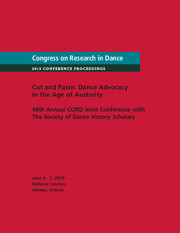No CrossRef data available.
Article contents
Labanotation and the Study of Human Movement in Anthropology
Published online by Cambridge University Press: 17 September 2015
Abstract
This paper discusses the ways in which Labanotation contributes to the analysis of human movement in anthropology. It is based on the experience of the authors, who, as graduate students in anthropology, were involved in research projects where they used Labanotation for the collection and analysis of data. We argue that the ability of Labanotation to accurately represent body movements and gestures, as well as the spatial relationships between moving agents, makes it useful for analyzing different dimensions of social life as enacted by moving bodies. It also records action from the moving person's point of view, which conforms to the ethnographic practice of taking into account local meanings attached to particular kinds of social action. As such, it can be used at different stages of ethnographic research and for different analytical purposes. To illustrate, we present topically diverse ethnographic projects where Labanotation was used: (1) documentation of the New Year ritual of the Lahu Na Shehleh from Northern Thailand for the purpose of preserving the dance and teaching it to younger members of the community, (2) understanding local meanings of ballet dancing in the Philippines, and (3) identifying tacit learning of social norms among children in Ayacucho, Peru.
Information
- Type
- Research Article
- Information
- Copyright
- Copyright © Kate Grim-Feinberg and Monica F. A. W. Santos 2015

